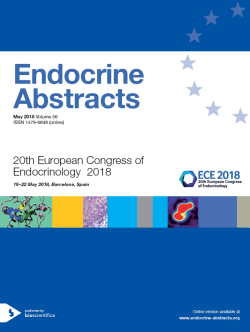
20th European Congress of Endocrinology
Barcelona,
Spain
19 May 2018 - 22 May 2018
Oral Communications
What is new in gestational and type 1 diabetes?
ea0056oc14.1 | What is new in gestational and type 1 diabetes? | ECE2018
Does insulin treatment differ in their impact on placental vascular circulation in obese and non obese women with gestational diabetes mellitus?
Shargorodsky Marina , Barda Gulia , Bar Jacob , Shraiber Letizia
ea0056oc14.2 | What is new in gestational and type 1 diabetes? | ECE2018
Profiling of activation patterns of placental mTOR in pregnancies complicated by gestational diabetes mellitus
Papadopoulou Anna , Valsamakis George , Thymara Irini , Laryngaki Anastasia , Theodorou Spyridoula , Grammatopoulos Dimitris , Papaevangelou Vasiliki , Mastorakos George
ea0056oc14.3 | What is new in gestational and type 1 diabetes? | ECE2018
Patrolling monocytes are activated in diabetes and provide protection to retinal vessels in the context of leukostasis
Tecilazich Francesco , Phan Toan , Simeoni Fabio , Dagher-Mansour Zeina , Lorenzi Mara
ea0056oc14.4 | What is new in gestational and type 1 diabetes? | ECE2018
The variability of glycemia and the metabolic composition of brain cells in patients with type 1 diabetes mellitus
Rotkank Maria , Samoylova Julia , Zhukova Natalia , Matveeva Mariia , Tolmachev Ivan , Leyman Olga
ea0056oc14.5 | What is new in gestational and type 1 diabetes? | ECE2018
Type 1 diabetes mellitus: defining the best cut-off points of arterial stiffness for predicting cardiovascular risk according to the Steno Type 1 Risk Engine
Cano Albert , Llaurado Gemma , Fabregas Lara Albert , Mazarico Isabel , Gonzalez-Sastre Montserrat , Gonzalez-Clemente Jose Miguel



